Configuration
Reading time ~9 minutes
The Cinegy Event Manager Configurator can be launched from Start > All Programs > Cinegy > Cinegy Event Manager > Event Manager Config.
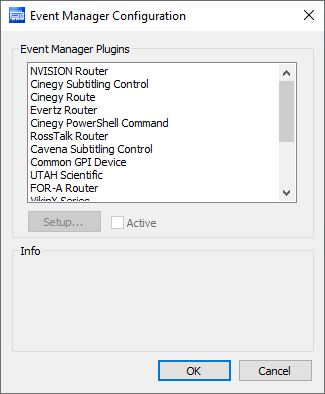
To configure the specified device, select it from the list of supported plug-ins and press the "Setup…" button.
Each device should be configured individually. The current settings of the selected devices are displayed within the "Info" field.
Select the "Active" checkbox to activate the selected plug-in.
NVISION Router
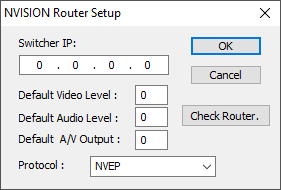
Here enter via the keyboard the switcher IP, default video and audio level values, and default A/V output value. Select the protocol type (NVEP or NVISION9000) from the corresponding drop-down list.
Press the "Check Router" button to check the NVISION router state.
Press "OK" to finish the NVISION Router setup.
Cinegy Subtitling Control
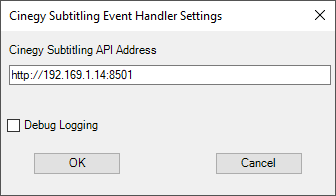
In the "Cinegy Subtitling API Address" field define the URL address in the following format: http://<server_name>:8501, where <server_name> is the server IP address or network name of the machine where Cinegy Subtitling Service is running.
The "Debug Logging" checkbox enables enhanced logging for troubleshooting purposes into the Cinegy Event Manager log. By default, this log can be stored at the following location: C:\ProgramData\Cinegy\CinegyAir.
Press "OK" to finish the setup.
Cinegy Route

Select the "Active" option, then press the "Setup" button. In the configuration window that appears, select the corresponding options to define the following parameters:
-
Default Route Server – default host link to be used by the Cinegy Route plug-in.
-
Default Stream Switcher Server – the machine where the Cinegy Stream Switcher service is installed. Enter the computer name via the keyboard or use the "…" button and select it from the list of available computers in the network.
-
Port – the Cinegy Stream Switcher control port.
In the "Default Channel" field define the default channel (by zero-based numerical index) to address.
|
Important
|
Refer to this article for more information on configuring Cinegy Stream Switcher. |
RossTalk Router

The configurator allows specifying a primary and secondary router for high-availability setups. Define the primary and secondary router IP addresses. If no secondary router exists, the "Secondary" field should be left blank. User ID is the numeric user/panel ID that will be used to request the switch.
Evertz Router

Here define the primary and secondary (if available) switcher control interface IPs and define their connection port numbers.
In the "Timeout" field define the time interval in seconds for Evertz Router to report a successful command completion; otherwise, an error is reported into the Event Service log file.
In the "Heartbeat" field specify the time interval in seconds for the event handler plug-in to report its status into the Event Service log file.
Select the "Check router on every heartbeat" option to additionally enable the Evertz Router status check-out. Having configured Evertz Router setup, press "Ok" to save the changes.
Cinegy PowerShell Command
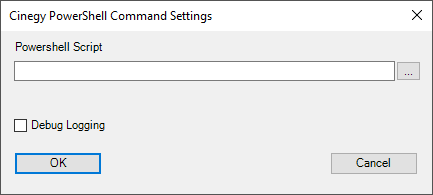
This plug-in allows Cinegy Event Manager to trigger a custom Microsoft PowerShell script. This script can be used to carry out any operation that might be desired - for example, making an HTTP REST request to a third-party device or triggering some custom parameters to be written to the log file. It allows simple extension to Cinegy Event Manager without any requirement for creating a full plug-in, and can be an excellent mechanism for prototyping device control.
|
Note
|
Please ensure that an up-to-date PowerShell installation is available and working on the Event Manager hosting server. Version 5.1 of PowerShell or later is recommended, although older versions may function, they remain untested. |
|
Caution
|
Please note that current Cinegy Event Manager is a 32-bit application, so you will need to set the execution policy for the 32-bit copy of PowerShell. |
To allow Cinegy Event Manager to execute PowerShell scripts, the execution policy for the current user needs to be changed. To do this, follow the steps:
-
Type
Powershellinto the Windows search bar. -
Click "Windows Powershell ISE (x86)" to launch it.
-
In the console that appears, type in
Get-ExecutionPolicy -Listto display the current execution policies. -
Type in
Set-ExecutionPolicy -ExecutionPolicy Bypass -Scope CurrentUserto change the execution policy to "Bypass" for the current user. -
Check the current status by execution 'Get-ExecutionPolicy -List'. The list will be as follows:
Scope ExecutionPolicy ----- --------------- MachinePolicy Undefined UserPolicy Undefined Process Undefined CurrentUser Bypass LocalMachine Undefined
|
Important
|
Read the following post to learn how to use Cinegy Event Manager to host a PowerShell script. |
The dialog allows the specification of the specific PowerShell file to call when Event Manager invokes the plug-in. This file should be accessible to the machine and/or any user account that Event Manager might be configured to run under.
The script that is executed will be passed a single object, generally referred to as a 'provider' object. This object contains methods to allow the script to push back messages to print into the Event Manager log output, as well as containing the details of the standard Event Manager arguments that are available to the script as inputs. The 'Device Name' parameter for this plug-in shall always be POWERSHELL to accept responsibility to execute.
An example script showing the available inputs and usage of the provider logging interface is available on GitHub here.
The Debug Logging checkbox enables enhanced logging for troubleshooting purposes into the Event Manager log. This log can be located by default at this location:
C:\ProgramData\Cinegy\CinegyAir
Press "OK" to finish the setup.
Cavena Subtitling Control
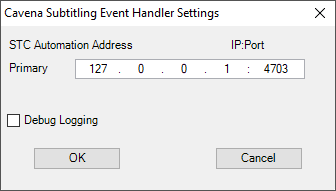
This plug-in allows Cinegy Event Manager to send control requests to Cavena subtitling software for the purpose of commanding real-time subtitle generation that may be combined with Cinegy Air output for broadcast.
|
Important
|
For more details about Cavena configuration and recommended architectures, please see this post. |
This dialog allows the specification of the primary Cavena Subtitle Transmission Control (STC) unit IP address and port.
The Debug Logging checkbox enables enhanced logging for troubleshooting purposes into the Event Manager log. This log can be located by default at this location:
C:\ProgramData\Cinegy\CinegyAir
Press "OK" to finish the setup.
Common GPI Device

Choose the required card model from the drop-down list.
For the SeaI/O-530E card model define card number (from 0 to 7) to be used to connect the GPI device. For the SeaMAX card model define the "Slave ID" parameter and IP protocol.
In the "Heartbeat" field specify the time interval in seconds for the event handler plug-in to report its status into the Event Service log file.
Select the "Check router on every heartbeat" option to additionally enable the selected GPI Device status check-out.
Press "OK" to finish the setup.
|
Note
|
Only SeaI/O-530E device controlled via Ethernet is supported for SeaMAX card model. |
|
Important
|
For the list of supported GPI video boards refer to the Cinegy Air System Recommendations. |
UTAH Scientific
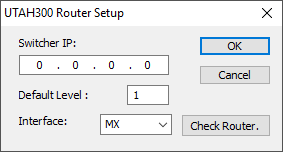
Use the keyboard to define the switcher IP to be used to connect the UTAH300 Router and default level. Choose the required Router interface type (MX, PL or Unet) from the corresponding drop-down list.
Press the "Check Router" button to check the UTAH300 Router state.
Press "OK" to finish the UTAH300 Router setup.
FOR-A Router
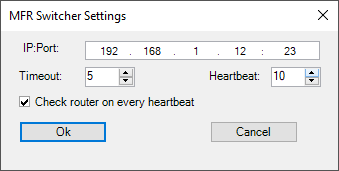
Define the router control interface IP address and port.
In the "Timeout" field define the time interval in seconds for FOR-A MFR Router to report a successful command completion; otherwise, an error is reported into the Event Service log file.
In the "Heartbeat" field specify the time interval in seconds for the event handler plug-in to report its status into the Event Service log file.
Select the "Check router on every heartbeat" option to additionally enable the selected router status check-out.
Press "Ok" to apply the changes.
VikinX Series
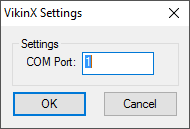
Here define the COM port number (from 1 to 8) to be used to connect the VikinX device and press "OK".
Kramer Devices
Port 1 is used to connect the Kramer device by default and cannot be changed.
Sencore IRD Control
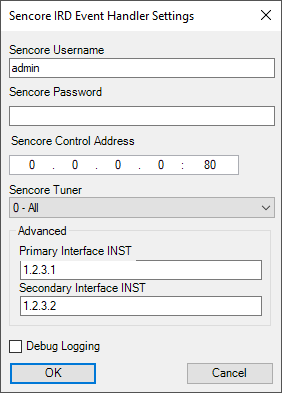
This plug-in allows Sencore IRD decoder / encoder hardware to be adjusted to different IP sources, for example allowing a Sencore device to be tuned to match Cinegy Route virtual destination whenever it is updated. It operates by using the Sencore REST API interfaces, which wrap SNMP configuration management calls within an HTTP protocol.
Every element in the config form may be over-ridden with each command sent, by setting a replacement value inside the OP1 name/value pair (these name/value pairs should be URL encoded if they contain any illegal characters for a URL).
The possible parameters are:
controlip
controlport
username
password
primaryinst
secondaryinst
tuneridx
Where any parameter is omitted, the defaults specified within this configuration form will be used instead. If no valid combination is specified, the device will fail to operate correctly and the Event Manager logs should be checked for more information.
An example set of arguments to trigger a Sencore IRD correctly, with a few parameters over-riden, is shown below:
DEVICE=SENCORE
COMMAND=TUNE
OP1=controlIp=10.186.4.70&controlport=80
OP2=
OP3=rtp://@239.5.2.1:1234?serviceid=53515
The dialogs that may provide defaults not specified within the OP1 string are described below:
Sencore Username (control parameter 'username') - this refers to the username that will be passed via web service calls when Event Manager issues commands to the Sencore device.
Sencore Password (control parameter 'password') - this refers to the username that will be passed via web service calls when Event Manager issues commands to the Sencore device.
Sencore Control Address (control parameters 'controlip' and 'controlport') - this refers to the TCP IP address port configured in the Sencore device that shall be used communicating with the Sencore device.
Sencore Tuner (control parameter 'tuneridx') - this refers to the tuner 'index' in the Sencore device that will be re-tuned during tuning events. You may select all available tuners to be updated (index 0), or specifically just the primary (index 1) or secondary (index 2) tuners to be updated.
Advanced: Primary Interface INST / Secondary Interface INST (control parameters 'primaryinst' and 'secondaryinst') - these text boxes allow updating the SNMP OID values associated in the Sencore device that are used when issuing commands. The default values should work, but upon encountering problems the 'Debug Logging' should be enabled and the Event Manager logs should be checked for feedback from the Sencore unit.
Debug Logging - this checkbox enables enhanced logging for troubleshooting purposes into the Event Manager log. This log can be located by default at this location:
C:\ProgramData\Cinegy\CinegyAir
Blackmagic Videohub
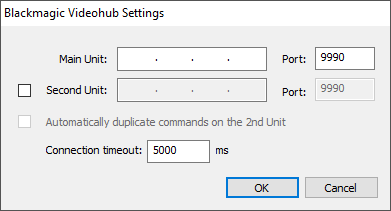
Use the keyboard to enter the main unit address and modify its port number, if needed. To enable the second unit, select the corresponding checkbox and define its parameters, as described for the main unit.
To duplicate commands on the second unit automatically, select the corresponding checkbox.
Define the desired connection timeout interval in milliseconds.
Press "OK" to finish the Blackmagic Videohub device setup.
Guramex Switcher
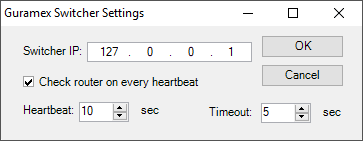
By using the keyboard, enter the switcher IP to be used for connection to Guramex Switcher.
In the "Heartbeat" field specify the time interval in seconds for the event handler plug-in status to be reported into the Event Service log file.
Leaving the "Check router on every heartbeat" option selected will additionally enable the Guramex Switcher status check-out.
Press "Ok" to apply the changes.
Cinegy HTTP Data Repeater Event Plugin

Here define the URL (e.g. http://127.0.0.1:8888/test/) to be used for HTTP POSTs.
Harris Router

Here enter the Harris Router address and port number. If Cinegy Event Manager is installed locally, "localhost" is defined by default.
Also, enter the login credentials and the desired heartbeat interval in seconds.
Select the "Pass-Through Protocol" checkbox to switch protocol type from terminal to pass-through.
Press "OK" to finish the Harris Router setup.